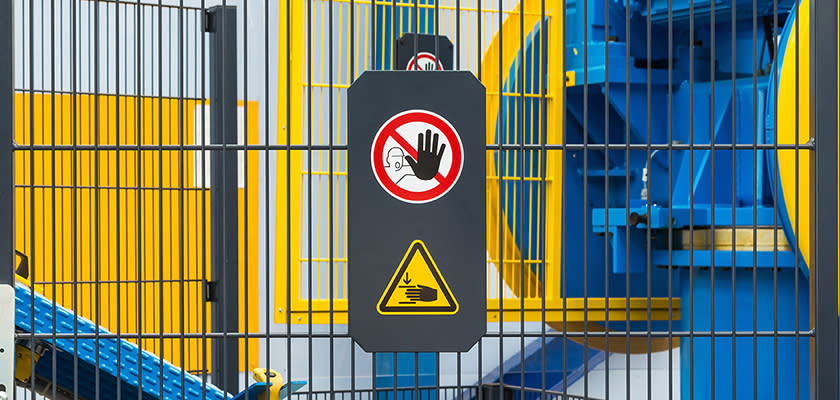Protect your team from the top hazard in automotive manufacturing: Tips to prevent exposure to hazardous energy

Workplace Safety & Prevention Services (WSPS) is a not-for-profit occupational health and safety association committed to ensuring every worker goes home healthy and safe at the end of the day. As your dedicated health and safety association for the automotive manufacturing industry, we are here to help with resources and support.
The automotive manufacturing industry and partners are working with WSPS to develop solutions that address the top risks for these businesses. In a recent study, this group identified the top risk in the sector as exposure to hazardous energy. For more information and to access resources on the other top hazards in automotive manufacturing, visit this page.
In this article:
- What is hazardous energy?
- Top 10 causes of exposure to hazardous energy in the automotive manufacturing industry
- Prevent exposure to hazardous energy with these 5 recommendations
- Resources and training
What is hazardous energy?

Hazardous energy can take many forms, including electrical, pressurized fluids or gases, mechanical,
chemical, and thermal energy. Exposure to hazardous energy can have catastrophic results for a
worker if they’re near a release of stored energy from a machine.
Top 10 causes of exposure to hazardous energy in the automotive manufacturing industry

- Inadequate training
- Lack of hazard identification/risk assessment
- Lack of/Inadequate documented program
- Lack of worker competency
- Accepted work norms
- Taking shortcuts
- Inadequate equipment
- Lack of monitoring
- Inadequate maintenance
- Performance evaluation
Prevent worker exposure to hazardous energy with these 5 recommendations

The working group made over 200 recommendations to address worker exposure to hazardous energy in the automotive manufacturing industry. Use the resources below to protect your team from unintended exposure to hazardous energy.
1. Increase and empower training for all employees. Ensure workers and supervisors know the hazards and consequences of exposure to uncontrolled hazardous energy. Include the following in your training plan:
- Create a training guide that is both generic and equipment-specific.
- Include instruction on trainer competency, verification of knowledge transfer, creation of a supportive learning environment, and follow-up (two-way communication).
- Train workers on the the relevant legal requirements.
2. Identify hazards and risks. Proactively address hazards to prevent injuries. Identify hazards by:
- Completing a risk assessment to identify hazardous energy hazards.
- Observing tasks, reviewing incident reports, and getting employee feedback.
- Performing job hazard analyses, risk assessments, and consulting with experts.
- Assessing work practices, procedures, and environmental factors to ensure a safer workplace.
3. Establish programs and procedures.
- Define roles, responsibilities, accountabilities, and involvement of staff and leadership.
- Define needs assessment (new/ modified equipment), application of lockout tag/out, required devices, etc.
- Provide clear equipment-specific procedures/placards written in simple language and use visual aids.
- Consider explaining the legislative requirements.
4. Ensuring equipment is adequately functioning will help maintain productivity and safety.
- Ensure the equipment is running as it was designed to and workers know how to use it properly.
- Conduct regular maintenance and inspections.
- Utilize technology.
- Provide training and empower workers with knowledge.
- Maintain accurate documentation and reporting, and integrate safety protocols into the maintenance routine.
5. Improving workplace culture. There are many benefits to implementing a healthy workplace culture.
- When workers feel safe and supported, they are more engaged and efficient. A positive workplace culture also helps drive innovation and productivity.
- Engage employees in safety programs, provide training, promote open communication, and create a safe environment.
- Prioritize open communication, collaboration, and employee well-being to make every team member feel valued and empowered.
Learn more about preventing worker exposure to hazardous energy

Consulting
Machine Safety & Robotics Consulting - WSPS machine safety and robotics experts can improve your understanding of the machine safety hazards and develop or enhance a lockout tag/out program. Our experts will work with you to identify effective safeguarding options to protect workers from hazardous energy.
Resources
- Lockout/tag out Training Guide (guide)
- Effective lockout training: 9 proven ways to get workers listening and learning (article)
- Working with machines safely - video and article. Also available in French, Mandarin, Punjabi, Spanish and Tagalog.
- Staying safe with hazardous energy: Using the Lockout Tagout procedure - video and article. Also available in French, Mandarin. Punjabi, Spanish and Tagalog.
- Is low risk perception a problem in your workplace? (article)
- Share with your workers: Manufacturing safety resources available in 6 languages
- Lockout/tag out worker resources – Staying Safe with Hazardous Energy, multi-language resources. Includes mobile-friendly video and ‘tips’ sheets. Available in French, Mandarin, Punjabi, Spanish, Tagalog, and English.
- Machine Safety Toolkit (guide)
- Quick Safety Tips: Lockout tag/out questions and answers (video series)
- Quick Safety Tips: Pre-Start Health and Safety Review questions and answers (video series)
- Safety Tips - Machine Safeguarding: Assess Your Safeguarding in Four Easy Steps (video)
- Safety Tips - Machine Safeguarding: Understand Your Risks (video)
- How can a JHSC conduct effective workplace inspections on-site? (video)
- Can supervisors be charged under the Occupational Health and Safety Act? (video)
- Duties & Responsibilities - The Occupational Health and Safety Act (article)
- JHSC Requirements Ontario Toolkit & Checklists
- The Effective JHSC Ontario: A Guide To Getting Started
- How to Identify and Assess Your Hazards: Using the WSPS Hazard Assessment Tool (video)
- Leaders: Do Your Employees Know You are Committed to Creating a Culture of Safety in Your Workplace? (Trusted Leader Blog)
- How to Enhance Employee Well-being: Lessons from a Global Authority on Workplace Culture (Trusted Leader Blog)
Training
- Lockout/Tag out (eCourse, 1 hour)
- Lockout/Tag out Safety Essentials (online, instructor-led, 0.5 day)
- Managing Pre-Start Reviews (online, instructor-led, 0.5 day)
- Managing Machine Safety (online, instructor-led, 4 hours)
- Electrical Hazards (eCourse, 1 hour)
- JHSC Certification Training (Part 1, Part 2 or Refresher Training, instructor-led online or self-paced)
- Supervisor Responsibilities & Due Diligence (online, instructor-led, 4 hours)
- The Effective Supervisor - Building Strategies for Success (online, instructor-led, 2 days)
- Effective Workplace Inspections (online, instructor-led, 3.5 hours)
- Certificate in Psychologically Safe Leadership (15 hours, Registration and delivery are done through University of New Brunswick)
Connect with an expert
If you’re ready to get started, or simply have questions about our services or approach, contact a WSPS specialist to find out more.





